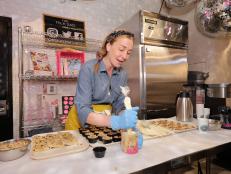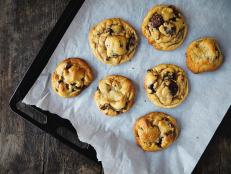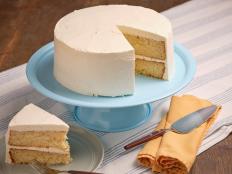What to Consider Before Baking for Others, According to a Pastry Chef
Here’s what to make when it comes to dinner parties, barbecues and solo indulgences.

Lara Hata/Getty
Pastry has always been created with function in mind. When first conceived, pastries were made to preserve. And while it’s difficult to pinpoint where pastry truly originated, nearly every culture seems to have a version of a dough patty or pie that is filled with meat or fish. According to the BBC, a first-century Roman cookbook, Apicius, included recipes for “pie cases” which were made with flour, water and oil and intended to only be used to preserve the juices and flavors of various meats – they were not eaten. Though they served as savory precedents, the formula of sealing anything in a dough to better the chances of keeping led to becoming a vehicle for sweet fillings: chocolate, creams, fruits and jellies. The next phase of pastry took cues from bread and involved experimenting with batters and leavening agents. This phase, specifically in Europe, was less about practical function and more about fashion and luxury. The more delicate the cakes, and the more “exotic” the ingredients, the more wealth was on display. Different royal courts used pastry to flaunt their new and exotic raw materials, thanks to the work of enslaved people in their vast colonies. Pastries went from being preservation-driven to a status symbol.
Today, pastries and dessert are still considered a luxury, fit largely for special occasions or moments of indulgence.
But in a turn of events, quarantining during the pandemic forced many to return to experiencing dessert, or rather all food in general, as a purely necessary part of their routine, and yet so much more. Through it, the end result wasn’t so important as the process itself. Many immersed themselves in baking as a means to create something with our hands while we were unsure if or when things would get better. We ate by ourselves or with only our immediate families, roommates or partners. The opportunity to make and experience food with company wasn’t possible, save virtually.
Baking became a means to fill time, stave off boredom and dread. But now that we finally have the chance to reunite with loved ones, taking all precautions of course, it’s time to embrace, once again, intentional baking – that is, creating pastries with a certain person, event or experience in mind.
Upcoming pastry chefs and various food endeavors in general have embraced this direction for the past few years and now, coupled with a slow (and precarious) return to social happenings, intentional spaces and food are slated to return. Pastry is tied to how it’s ultimately eaten and when this is incorporated into the process of creating pastry, the deliberateness shines through.
Tailoring to the occasion is more than just using flavors the birthday person loves— it’s also about who is sharing this moment, where and how. Pastry is multidimensional at its best; it reaches true perfection when every aspect of its enjoyment is taken into account.
At its most basic, pastry is merely some kind of dough made with flour, shortening of some kind and a liquid component that is usually a vessel for cream or fruit. But as a dessert, a ritual, pastry can be a vessel for conversation, celebration, company or capturing a moment. That’s a lot of pressure for whomever might be donning the pastry chef hat for the night. As a professional pastry chef, I’ve had my fair share of creating bespoke desserts. Here’s what I’ve learned to consider before baking for different occasions.

Maya Shustov/Getty
You’re ready for a slower, laidback dinner at home with a few of your favorite people… what to consider for a dinner party:
Did you, the host, devise the whole menu or is it a potluck with a collection of dishes that speak for different chefs and cravings?
As a host, you could choose to make a dessert that showcases a fruit that is in season. Something as simple as a plum tart with vanilla pastry cream goes a long way! The tart is relatively easy to make and the fruits (at peak season) always taste luxurious. Barring allergies, a dessert highlighting fruits at their best will bring a smile to your guests’ faces. Because tarts are easier to make, hosts can impress with a treat that takes less time to put together, allowing you to focus on the time-intensive mains you’ve planned.
As a guest, you can play the wildcard. Guests get the luxury of arriving to dinner parties when most other aspects of the meal are underway and taken care of, with one thing in hand. With time to focus on one part of the dinner, guests can afford to get creative and make something they’ve never made before, or even heard of. This can be ile flottante with fresh fruits or a chiffon cake made with flavors you haven’t tasted. The novelty of it will lead to interesting conversation with everyone.

Liubov Gorosko/Getty
It’s the last official month of summer, it’s time to dine al fresco… what to consider for a barbecue or picnic:
This past 4th of July, I made the mistake of making a layered honey cake with a cucumber mint mousse. I had only just created the recipe and thought it would be perfect for a summer’s day. What I failed to consider was that a barbecue is an interactive meal and so, in turn, the dessert should have followed suit. The beauty of barbecues is its flexibility – unconstrained by the formality of a coursed meal, guests are free to eat appetizers, mains or desserts at any point throughout the event. One could choose to eat their burger after some ice cream and before their salad. Another can start with fruits and desserts and move to their hot dogs and other mains as the heat of the day subsides. Barbecues are customizable so it’s important the desserts or pastries follow suit. So while the flavors of the honey cake were perfect for the heat, it didn’t consider the nature of the event. My guests enjoyed its flavor, but interest in a slice of cake quickly dwindled.
A better choice for such a gathering might have been cream puffs with the filling pre-made but left out so guests could take part in assembly. The cream puffs are easy to scale to whatever number of guests you’re expecting (and allows for easy seconds or thirds). They incorporate the fun of interaction and personalization before eating. Plus, they’re smaller and lighter – which is a more enticing option during a day by a pool and/or grill.

Jamie Grill/Getty
You’re feeling extra reflective this birthday and thinking about your last and next trip around the sun on your own… how to treat yourself just because or for your solo birthday celebration:
There is certain peace in choosing to spend your birthday in solitude. For someone who would like to just be alone – but celebrate properly nonetheless – bake a mini cake that looks like one big slice.
You can make a full cake and cut out the slice or to save ingredients, you can make the cake layers in sheet pans, cut them into a slice shape and fill with a proportional amount of icing. You’ll have several slices to eat whenever you want! If made to look like a slice, the person can still feel like they are partaking in some collective celebration, but still savor the beauty of solitude. Focus on your favorite flavors and make them shine.
You can also choose to concentrate on the process. Perhaps there’s an idea you have been wanting to try or an involved treat you haven’t made the time to even consider attempting. Break your recipe down into small parts and focus on the wonder of creating something of your dreams with your own hands. Make macarons with a rich homemade hazelnut chocolate filling or challenge yourself to something extravagant. Take your time, have fun, relax and when you finish, you’ll be glad you finally did it!
Related Content:


































